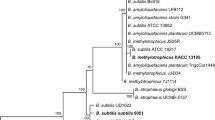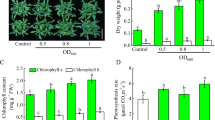Abstract
Several chemical changes in soil are associated with plant growth-promoting rhizobacteria. An endosporeforming bacterium, strain XTBG34, was isolated from a Xishuangbanna Tropical Botanical Garden soil sample and identified as Bacillus megaterium. The strain’s volatiles had remarkable plant growth promotion activity in Arabidopsis thaliana plants; after 15 days treatment, the fresh weight of plants inoculated with XTBG34 was almost 2-fold compared with those inoculated with DH5α. Head space volatile compounds produced by XTBG34, trapped with headspace solid phase microextraction and identified by gas chromatography-mass spectrometry, included aldehydes, alkanes, ketones and aroma components. Of the 11 compounds assayed for plant growth promotion activity in divided Petri plates, only 2-pentylfuran increased plant growth. We have therefore identified a new plant growth promotion volatile of B. megaterium XTBG34, which deserves further study in the mechanisms of interaction between plant growth-promoting rhizobacteria and plants.
Similar content being viewed by others
References
Altschul, S., T. Modden, A. Schafer, J. Zhang, W. Miller, and D. Lipman. 1997. Gapped BLAST and PSIBLAST: a new generation of protein database search programs. Nucleic Acids Res. 25, 3389–3404.
Augusto, F. and A.L.P. Valente. 2002. Applications of solid-phase microextraction to chemical analysis of live biological samples. Trac-Trend. Anal. Chem. 27, 6–7.
Cakmakci, R., F. Donmez, A. Aydín, and F. Sahin. 2006. Growth promotion of plants by plant growth-promoting rhizobacteria under greenhouse and two different field soil conditions. Soil Biol. Biochem. 38, 1482–1487.
Choi, O., J. Kim, J.G. Kim, Y. Jeong, J.S. Moon, C.S. Park, and I. Hwang. 2008. Pyrroloquinoline quinone is a plant growth promotion factor produced by Pseudomonas fluorescens B16. Plant Physiol. 146, 657–668.
De Freitas, J.R., M.R. Banerjee, and J.J. Germida. 1997. Phosphatesolubilizing rhizobacteria enhance the growth and yield but not phosphorus uptake of canola (Brassica napus L.). Biol. Fertil. Soils 24, 358–364.
Ercolani, G.L. 1991. Distribution of epiphytic bacteria on olive leaves and the influence of age and sampling time. Microb. Ecol. 21, 35–48.
Farag, M.A., C.M. Ryu, L.W. Sumner, and P.W. Pare. 2006. GC/MS SPME profiling of rhizobacterial volatiles reveals prospective inducers of growth promotion and induced systemic resistance in plants. Phytochemistry 67, 2262–2268.
Felsenstein, J. 1985. Confidence limits on phylogenies: an approach using the bootstrap. Evolution 39, 783–789.
Glick, B.R. 1999. Biochemical and genetic mechanisms used by plant growth promoting bacteria, pp. 1–13. Overview of plant growthpromoting bacteria. Imperial College Press, London, UK.
Kloepper, J.W., J. Leong, M. Teintze, and M.N. Schroth. 1980. Enhanced plant growth by siderophores produced by plant growthpromoting rhizobacteria. Nature 286, 885–886.
Kloepper, J.W. and M.N. Schroth. 1978. Plant growth-promoting rhizobacteria on radishes. In Proc. of the 4th Int. Conf. on Plant.
Kloepper, J.W. and M.N. Schroth. 1981. Relationship of in vitro antibiosis of plant growth-promoting rhizobacteria to plant growth and the displacement of root microflora. Phytopathology 71, 1078–1082.
Kloepper, J.W., R.M. Zablotowicz, E.M. Tipping, and R. Lifshitz. 1991. The rhizosphere and plant growth, pp. 315–326. Netherlands.
Kumar, S., J. Dudley, M. Nei, and K. Tamura. 2008. MEGA: A biologist-centric software for evolutionary analysis of DNA and protein sequences. Brief Bioinform. 9, 299–306.
Lane, D.J. 1991. 16S/23S rRNA sequencing. Nucleic acid techniques in bacterial systematic, pp. 115–175. Wiley, New York, N.Y., USA.
Leong, J. 1986. Siderophores: Their biochemistry and possible role in the biocontrol of plant pathogens. Annu. Rev. Phytopathol. 24, 187–209.
Li, Y.P. and B. Wilhelm. 2004. Signals from the underground: bacterial volatiles promote growth in Arabidopsis. Trends Plant Sci. 6, 263–266.
Lin, W., Y. Okon, and R.W.F. Hardy. 1983. Enhanced mineral uptake by Zea mays and Sorghum bicolor roots inoculated with Azospirillum brasilense. Appl. Environ. Microbiol. 45, 1775–1779.
Liu, Z.L. and B.J. Sinclair. 1993. Colonization of soybean roots by Bacillus megaterium B 153-2-2. Soil Biol. Biochem. 25, 849–855.
Liu, X.M., H.X. Zhao, and S.F. Chen. 2006. Colonization of maize and rice plants by strain Bacillus megaterium C4. Curr. Microbiol. 52, 186–190.
Loper, J.E. and M.N. Schroth. 1986. Influence of bacteria sources of indol-3-acetic acid on root elongation of sugar beet. Phytopathology 76, 386–389.
MacDonald, E.M.S., G.K. Powell, D.A. Regier, N.L. Glass, F. Roberto, T. Kosuge, and R.O. Morris. 1986. Secretion of zeatin, ribosylzeatin, and ribosyl-1-methylzeatin by Pseudomonas savastanoi 1 plasmid-coded cytokinin biosynthesis. Plant Physiol. 82, 742–747.
Rabouille, S., M. Staal, L.J. Stal, and K. Soetaert. 2006. Modeling the dynamic regulation of nitrogen fixation in the Cyanobacterium Trichodesmium sp. Appl. Environ. Microbiol. 72, 3217–3227.
Ryu, C.M., M.A. Farag, C.H. Hu, M.S. Reddy, H.X. Wei, P.W. Pare, and J.W. Kloepper. 2003. Bacterial volatiles promote growth in Arabidopsis. Proc. Natl. Acad. Sci. USA 100, 4927–4932.
Safronova, V.I., V.V. Stepanok, G.L. Engqvist, Y.V. Alekseyev, and A.A. Belimov. 2006. Root-associated bacteria containing 1-aminocyclopropane-1-carboxylate deaminase improve growth and nutrient uptake by pea genotypes cultivated in cadmium supplemented soil. Biol. Fert. Soils 42, 267–272.
Saitou, N. and M. Nei. 1987. The neighbor-joining method: a new method for reconstructing phylogenetic trees. Mol. Biol. Evol. 4, 406–425.
Sivan, A. and I. Chet. 1992. Microbial control of plant diseases, pp. 335–354. Wiley-Liss.
Thompson, J.D., T.J. Gibson, F. Plewniak, F. Jeanmougin, and D.G. Higgins. 1997. The CLUSTAL_X windows interface: flexible strategies for multiple sequence alignment aided by quality analysis tools. Nucleic Acids Res. 25, 4876–4882.
Tian, R.R., Y.H. Xie, W.W. Zhu, Y.H. Li, and Y. Zhang. 2007. Activities and toxicity of a novel plant growth regulator 2-furan-2-yl-[1,3] dioxolane. J. Plant Growth Regul. 26, 362–368.
Timmusk, S., B. Nicander, U. Granhall, and E. Tillberg. 1999. Cytokinin production by Paenibacillus polymyxa. Soil Biol. Biochem. 31, 1847–1852.
Wady, L., A. Bunte, C. Pehrson, and L. Larsson. 2003. Use of gas chromatography-mass spectrometry/solid phase micro-extraction for the identification of MVOCs from moldy building materials. J. Microbiol. Methods 52, 325–332.
Xie, H., J.J. Pasternak, and R.G. Bernard. 1996. Isolation and characterization of mutants of the plant growth-promoting rhizobacterium Pseudomonas putida GR12-2 that overproduce indoleacetic acid. Curr. Microbiol. 32, 67–71.
Author information
Authors and Affiliations
Corresponding author
Rights and permissions
About this article
Cite this article
Zou, C., Li, Z. & Yu, D. Bacillus megaterium strain XTBG34 promotes plant growth by producing 2-pentylfuran. J Microbiol. 48, 460–466 (2010). https://doi.org/10.1007/s12275-010-0068-z
Received:
Accepted:
Published:
Issue Date:
DOI: https://doi.org/10.1007/s12275-010-0068-z




